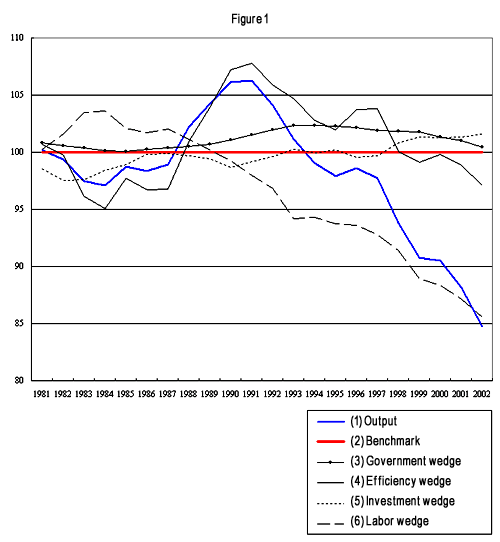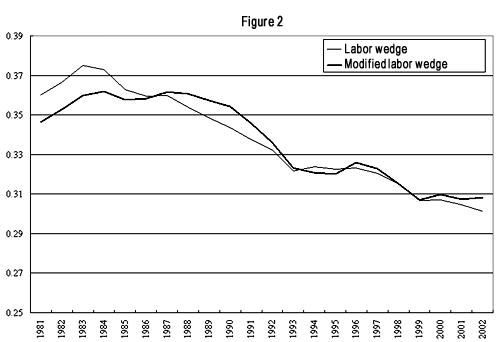With concerns about a deflationary spiral and a financial crisis largely over, it seems the Japanese economy has almost returned to normal. But we have yet to see a commonly accepted and clear-cut theory as to what factors were responsible for the prolonged economic recession that lasted for more than a decade.
In this column, I present the results of an analysis of the Japanese economy using a method called "business cycle accounting (BCA)" and examine what factors were crucial contributors to the prolonged economic recession (for detailed analytical results, refer to the RIETI Discussion Paper: "Business Cycle Accounting for the Japanese Economy").
What is business cycle accounting?
Even if we do not know the exact cause of a particular recession, we can obtain clues to infer the cause of and solutions to the recession by measuring the "wedge" distortions that occur in various sectors of the economy such as the investment, labor and fiscal sectors. Business cycle accounting has been proposed by a group of economists at the University of Minnesota (V. V. Chari, P. J. Kehoe and E. R. McGrattan) as a way of measuring these wedges.
Assuming an economy can be approximated by a neoclassical economic growth model, we can derive a relational equation that is theoretically valid when each sector is efficient. For example, provided that labor inputs remain efficient, the marginal rate of substitution between consumption and leisure (MRS, i.e., the increase in consumption for which a consumer is willing to work by sacrificing one extra unit of leisure) should theoretically be equal to the marginal productivity of labor (MPL, i.e., the increase in production from each additional unit of labor). However, when labor inputs become inefficient for whatever reason, MRS and MPL do not match. The degree of discrepancy between MRS and MPL shows the size of the wedge for labor input. We can measure the wedges for investment and productivity in the same way.
With respect to the measured wedge of each sector in the economy, model simulations can also be performed to show how economic performance would change with or without the wedge. If there is little difference in the results with or without investment wedge, for example, we can conclude that distortion in the investment sector had little impact on the economic performance. Thus, by performing simulations, we can infer which wedges were crucial contributing factors to the so-called lost decade in Japan.
Accounting for the prolonged economic recession of Japan
Figure 1 below shows the results of simulations for various sectors in the Japanese economy. First, we calculated the degree of distortion in labor input, capital investment, change in productivity, and change in government expenditure - the labor, investment, efficiency and government wedges, respectively - as plausible factors contributing to the recession. The contribution of these wedges to the change in gross national product (GNP) is shown in Figure 1.

The bold line (1) shows real economic output as measured by GNP. The straight line (2), which represents the benchmark, shows GNP held at a constant, based on the assumption that all the four wedges - labor, investment, efficiency and government - remain at their respective values in the 1980s. This is the benchmark for measuring fluctuations in economic performance from the 1990s onward. Lines (1) and (3)-(6) indicate relative values against a benchmark GNP of 100 (1981=100).
The government wedge, that is, the impact of changes in government expenditure on the economy, is shown by line (3). Line (3) stays above the benchmark throughout the 1990s, which means that fiscal expenditure continued to have a stimulative effect on the economy in the 1990s. It should be noted that this effect was not lost even in 1997 when the consumption tax rate was raised to 5%. Thus, the conventional view that the consumption tax hike triggered the deterioration of the economy does not match the BCA results.
The efficiency wedge, which is the change in output attributable to changes in productivity, is shown by line (4). The shape of this line resembles that of line (1), which represents actual output, but line (4) remained above the benchmark until the late 1990s, the time when Japan was hit by a financial crisis. This suggests that the depressive effect of the decline in productivity was not so strong during the early and mid 1990s. One widely held theory attributes the prolonged recession to an unexplained decline in productivity. But the BCA results point to the possibility that the decline in productivity might have not been a major contributor to the prolonged recession.
The investment wedge - the change in the economy attributable to distortions in capital investment - is shown by line (5). This line remained close to the benchmark in the 1990s, suggesting that a decline in private-sector capital investment was not a major cause of the deterioration of the economy. This also contradicts somewhat the generally accepted notion that underinvestment by the private sector, which arose as many companies suffered from debt overhangs and the credit crunch, was responsible for the recession. According to the BCA results, the investment channel might not have been inefficient.
What is apparent is that distortions in labor input were a major factor in the recession. Line (6) shows the depressive effect of labor input on the economy. We can see that the labor wedge deteriorated sharply from the beginning of the 1990s. When we compare this with the other wedges, it is clear that distortions in labor input were the biggest contributor to the prolonged recession.
Why did labor input deteriorate?
The BCA results show that the increased distortion in labor input (i.e., the increasing discrepancy between MRS and MPL) contributed to the prolonged recession. There are several possible explanations for this increasing inefficiency of labor input.
One is that distortions in labor input occurred as a result of long-term structural changes in the Japanese economy. If so, changes in the labor wedge must have been occurring long before the recession, that is, independent of the recession. One illustration of this is when employees' bargaining power in wage negotiations is increasing as a result of a rise in their social status. This may be reflected in the data in the form of increasing distortions in labor input.

Figure 2 shows the change in the labor wedge over the last two decades. We can see that the labor wedge (shown by the light gray line) began to deteriorate in 1984. However, this may be the result of measurement error. Indeed, recalculation using a modified production function1 gives the bold line, which shows that the deterioration of this modified labor wedge began only after the recession. It is therefore possible that the original finding - that the deterioration of the labor wedge began prior to the onset of the recession - is the result of measurement error.
If the deterioration of the labor wedge and the recession began at the same time, what caused the deterioration of the labor wedge? A standard explanation points to sticky wages (or downward rigidity). This wage rigidity, combined with a deflationary shock, such as a contractionary monetary policy, pushes up real wages, resulting in inefficient labor input. This explanation fits with what actually occurred in the early 1990s: The Bank of Japan tightened monetary policy sharply in the final phase of the bubble economy. But the explanation appears to contradict the data from the latter half of the decade. Although the labor wedge continued to deteriorate throughout the 1990s and afterward, real wages began to fall in the mid-1990s. Had the rise in real wages contributed to the deterioration of the labor wedge, the rise in real wages should have continued in the second half of the 1990s.
What then can account for the continued deterioration of the labor wedge in the latter half of the 1990s? My preferred hypothesis is that declines in land and share prices may have aggravated the labor wedge, with this negative impact coming in the form of collateral constraints. When collateral constraints are incorporated into a standard neoclassical growth model, a decrease in collateral values depresses consumption, causing a decrease in labor input. That is, it appears that in an economy where collateral constraints exist, the labor wedge deteriorates when asset prices continue to fall. This hypothesis seems convincing given that loans backed real estate are the primary means of financing in Japan and that land prices continued to fall in the second half of the 1990s and afterward.
BCA analysis of the Great Depression in the U.S. also shows that the labor wedge sharply deteriorated from the 1930s onward. The deterioration of the labor wedge thus appears to be significantly associated with the occurrence of a Great Depression-type slump. Clarifying why the labor wedge deteriorates during such slumps is a major challenge in establishing a viable economic theory of prolonged recessions.


